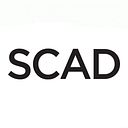Victoria Wanjuhi’s creative upcycling
Peter Relic
In a department that openly advocates sustainable design, fibers student Victoria Wanjuhi’s master’s thesis, “Cluster,” is an ingenious commentary on the global textile and fashion industries. Her work is also wildly enjoyable as abstract art.
Wanjuhi (pronounced Wa-jo-he) received her B.F.A. in fashion design from SCAD Atlanta in 2013, worked in the garment industry as an assistant designer for four years (“I saw how much waste was created with mass-produced clothing”), then came to SCAD Savannah to pursue her fibers M.F.A.
“Cluster” emphasizes the importance of rethinking discarded materials. While Wanjuhi refers to her accompanying thesis paper as “an exhibition catalog,” her writing is a rigorously researched analysis of the effects of the first world shipping undesirable fabric to less developed nations. Wanjuhi studied how specific communities in Kenya, India, and Brazil deal with the deluge, inspiring her to create the extraordinary “Cluster.”
Victoria Wanjuhi:
When I was a teenager, I used to deconstruct denim; I’d cut it up and sew it back together. I’d heard this term “fashion designer” and googled the best fashion school. SCAD came up. I spoke to a recruiter, and showed her a dress I was making out of boxes. I thought, they won’t take me, it’s too strange. But SCAD said yes! My SCAD journey, including the years between degrees I spent working, has been a decade of discovery.
Upon entering the graduate program at SCAD, I took a knitting class with professor Liz Sargent. I was reminded how much I loved working in abstract forms. Then I took a printmaking class that allowed me to explore how I could transfer my tactile fiber works into two-dimensional prints. Techniques from different disciplines became essential to my fibers projects. My thesis work explores processes including machine knitting, printmaking, and jacquard weaving.
I went to visit Kenya in 2018, after 10 years away, with my Mom. It was a good time to go. That was the start of exploring the craft of beading practiced by Maasai women. The result was “Scraps of Denim,” a set of four Jacquard woven pieces, using leftover threads from my previous projects, embellished with colorful Maasai glass beads to create color contrast with the blue background. I collaborated with Noonkokua Enole Naingisa, a local artisan based in Maasai Mara. We designed the layout of the beadwork for textiles, while the sequence of beading was based on her artistic decisions.
Kibera, in Nairobi, along with the Brazilian favelas in Rio, and Dharavi in Mumbai, India, are resourceful communities that have taken ownership of their environments. From the outside, these alternative communities appear endless and clustered; when you enter, you realize that there is an underlying organization at play and that the inhabitants are aware of their footprint within their communities.
SCAD taught me that having access to diverse creative fields is a huge advantage. I collaborated with Juanita Holmes (B.F.A., fashion, 2013) to create handcrafted couture shoes from upcycled material, and with Victoria Lake (M.F.A., animation) to create a 3D depiction of the favelas.
By exploring the possibilities and potential of materials, we can give new life to what has been discarded. “Cluster” reflects my world view. I’m proud of my SCAD experience.
